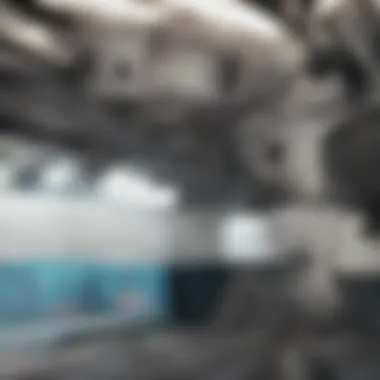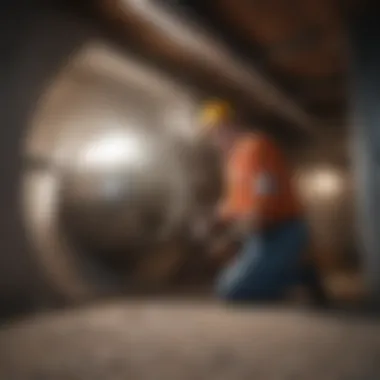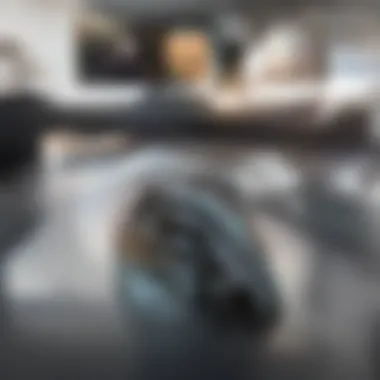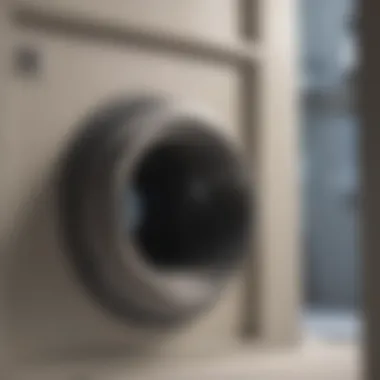Replacing Dryer Ducts: Essential Guide for Homeowners


Intro
Replacing dryer ducts is often an overlooked but crucial aspect of home maintenance. Many homeowners may not realize the significant role these ducts play in ensuring a dryer functions efficiently and safely. A worn-out or obstructed duct can lead to performance issues, increased energy consumption, and even fire hazards. This guide aims to provide a comprehensive overview of the process involved in replacing dryer ducts while addressing common pitfalls and sustainable practices that align with modern living standards.
Understanding the fundamentals of dryer duct replacement is not just beneficial for convenience but also for safeguarding one’s home. It is an investment in both safety and efficiency. The following sections will delve deeper into various elements that encompass this important home maintenance task.
Understanding Dryer Ducts
Dryer ducts play a crucial role in the functioning of a household appliance that is often taken for granted. Their primary function is to vent the hot, moist air produced by clothes dryers outside, preventing damage to the home and enhancing drying efficiency. Understanding dryer ducts helps homeowners appreciate their significance in maintaining a safe and effective laundry space.
Properly installed and maintained dryer ducts can lead to improved energy efficiency, reducing utility bills and minimizing wear on the dryer. Knowledge of dryer ducts aids homeowners in recognizing potential issues that may arise due to improper installation or outdated materials. This section examines the anatomy and installation of dryer ducts, providing insight into why attention to this aspect of home maintenance is necessary.
What Are Dryer Ducts?
Dryer ducts, also known as dryer vents, are typically made from metal or flexible plastic tubing that directs the airflow generated by the dryer from the appliance to the exterior of the home. The design of the duct includes several crucial components:
- Material: Standard materials include aluminum, galvanized steel, or semi-rigid plastics. Aluminum is preferred for its fire resistance and durability.
- Diameter: Commonly, dryer ducts have a diameter of 4 inches, though this can vary slightly based on the dryer type and model.
- Length: Ideally, ducts should be as short as possible to minimize airflow resistance, preventing overheating and maintaining efficiency.
The effectiveness of dryer ducts directly impacts not only the performance of the dryer but also the safety of the home. A well-functioning duct system allows moisture and heat to escape, essential for preventing hazards such as lint buildup, which can significantly increase fire risks.
Importance of Proper Installation
The installation of dryer ducts is a critical factor that influences both safety and performance. Improper installation can lead to numerous issues, such as:
- Restricted Airflow: Long or poorly configured ducts can impede airflow, forcing dryers to work harder than necessary. This not only wastes energy but can also lead to premature appliance failure.
- Increased Lint Buildup: If ducts are not installed correctly, they may trap lint and debris. This accumulation is a leading cause of dryer fires.
- Moisture Issues: Improperly vented ducts can cause humid air to enter the house, leading to mold growth and structural damage.
For these reasons, it is imperative to follow manufacturer guidelines and possibly consult professionals during the installation of dryer ducts. Homeowners should prioritize using appropriate materials and ensuring all connections are tight and secure to maximize safety and functionality.
Proper installation of dryer ducts not only enhances appliance efficiency but is also essential for maintaining a safe laundry environment, safeguarding against potential fire hazards. Source
Understanding these fundamentals of dryer ducts will provide a solid foundation for recognizing why they require replacement or maintenance. This knowledge leads seamlessly into the next section, where we explore the specific reasons for replacing dryer ducts.
Reasons to Replace Your Dryer Ducts
Dryer ducts play a critical role in the functionality of laundry appliances, supporting efficient venting of moisture and lint. Over time, various factors can necessitate their replacement. Understanding these reasons helps homeowners make informed decisions, ultimately enhancing the safety and efficiency of their homes.
Age and Wear of Existing Ducts
As with any building component, dryer ducts endure wear and tear over time. Most ducts are made from materials like plastic or aluminum. Plastic ducts can become brittle and crack, while aluminum ducts can corrode. Age is not the only factor; regular use can also lead to those ducts becoming less effective.
When ducts are older, they may experience more frequent clogs. Dust, lint, and debris accumulate at a higher rate, obstructing the airflow. This can place additional stress on the dryer itself, making the appliance work harder and increasing energy consumption. Regular inspections are important. If you find that your duct is more than a few years old, it may be time to consider a replacement.
"Neglecting the age of your dryer ducts could lead to unforeseen dangers, including fire hazards and inefficiency."
Increased Risk of Fire Hazards
One of the most concerning reasons to replace dryer ducts is the potential risk of fire. Lint buildup is a serious hazard. According to the National Fire Protection Association (NFPA), approximately 15,500 dryer fires occur annually in the United States, often due to improper venting. If lint accumulates in the duct, it can ignite and cause a fire, putting lives and property at risk.
Replacing the ducts with proper materials can mitigate this risk. For instance, using hard metal ducts reduces the flammability and is less prone to clogs compared to flexible plastic alternatives. Regular cleaning of the ducts can also significantly lower fire risks. Homeowners should remain vigilant and consider upgrades to duct systems that offer better fire resistance.


Inefficiency in Drying Performance
A dryer that takes longer to dry clothes is not just an annoyance; it signals a problem. Clogged or faulty ducts lead to inefficient drying performance. Diminished airflow means that moisture is not vented out as effectively. This results in clothes taking longer to dry and may cause heat buildup in the dryer. This inefficiency can translate into higher utility bills and unnecessary wear and tear on the appliance.
To improve drying efficiency, replacing old or damaged ducts is essential. Using smooth, straight ducts also optimizes air movement and facilitates quicker drying. Homeowners should evaluate their drying cycles regularly. A marked increase in time or poor drying results may indicate that a duct replacement is needed.
Ensuring that your dryer ducts are functioning correctly can save time, reduce costs, and improve the overall safety of your home.
Essential Tools and Materials
Replacing dryer ducts requires a careful selection of tools and materials. The right tools ensure efficiency and effectiveness in the replacement process. By using specific items designed for this task, one can avoid complications that arise from using improper or makeshift tools. Furthermore, quality materials contribute significantly to the longevity and safety of the installation. They prevent potential issues, such as leaks or airflow obstruction.
Tools Required
Dryer Duct Hose Clamp
The dryer duct hose clamp is essential for securing the duct to the vent and the dryer itself. Its primary function is to create an airtight seal that prevents the escape of hot air and lint. A crucial characteristic of a hose clamp is its adjustability. It allows for a snug fit on various duct diameters. This makes it a favorable choice for many. The unique feature of this clamp is its strong grip while remaining easy to install. However, it’s vital to ensure that these clamps are not over-tightened, as this could damage the duct.
Utility Knife
A utility knife plays a critical role when cutting the ducting material to the right lengths. Its sharp blade allows for precise cuts without fraying the edges. A key characteristic of a utility knife is its retractable design, which enhances safety during use. This tool is favored for its ease of maneuverability. The ability to make clean cuts aids in the overall installation of the duct system. However, one must handle it with care to avoid accidents that could cause injury.
Drill
A drill is often needed for creating holes for screws or anchors during the ducting installation. This tool can handle different bit sizes, making it versatile. Its power allows for swift and efficient work on various materials, often reducing overall time spent on the job. A battery-operated drill's portability is a plus, as it allows one to access tight spaces around the dryer area. However, one needs to choose the correct speed and drill type to suit the material being worked on, preventing potential damage to structures.
Screwdriver
The screwdriver is fundamental for fastening the screws in place as the duct is installed. It comes in various sizes and types, allowing for flexibility based on the screws used. A significant characteristic of a screwdriver is its ergonomic handle design, which helps reduce fatigue during prolonged use. This tool is a standard choice because of its simplicity and effectiveness. However, one should ensure to select the correct head type to fit the screw, as the wrong type may lead to stripping the screw.
Materials Needed
Flexible Aluminum Ducting
Flexible aluminum ducting is a critical material for replacing dryer ducts. Its primary advantage lies in its flexibility, allowing for easy installation in tight spaces. A key characteristic of aluminum ducting is its resistance to heat. This quality is vital in preventing any fire hazards from excessively hot air. Its lightweight nature makes it easy to handle during replacement. However, it may be more prone to kinking compared to rigid ducting, which can reduce airflow.
Duct Tape
Duct tape is a versatile material that plays an important role in sealing joints in ducting. Its strong adhesive quality ensures that connections remain secure and prevent air leaks. A major characteristic of duct tape is its water-resistant properties, which help maintain the integrity of the ducting in damp environments. It is commonly recommended because it is readily available and easy to use. However, one should avoid using duct tape for securing the entire length of the duct, as it may not withstand prolonged heat exposure.
Dryer Vent Hood
A dryer vent hood is a necessary component that protects the ducting from outdoor elements and critters. Its design allows for proper airflow while preventing backdrafts. A key characteristic of a vent hood is its flap mechanism, which opens when the dryer is operating. This feature maximizes energy efficiency and performance. Choosing a vent hood made from durable materials is beneficial as it provides long-lasting protection. However, one may encounter more expensive options that might not provide significant added value over less costly models.
Step-by-Step Guide to Replacing Dryer Ducts
Replacing the dryer ducts in your home is crucial for both operational efficiency and safety. A well-functioning dryer duct system not only enhances drying performance but also minimizes fire risks. This step-by-step guide breaks down the essential actions required for a successful replacement. Each step gives you clear direction on how to proceed while considering safety precautions.
Preparation and Safety Measures
Before beginning this task, proper preparation is key. First, ensure the work area is clear of any furniture or obstructions. This allows for safe movement around the appliance. Make sure you have the necessary tools and materials on hand, as this will expedite the process.


Safety measures are non-negotiable. Unplug your dryer to avoid any electrical shocks. Additionally, wearing gloves and safety goggles can protect you from sharp edges or dust. As you prepare, keep a fire extinguisher nearby. This may seem excessive, but it’s wise when working with appliances that generate heat and lint.
Removing the Old Duct
Removing the old duct requires a systematic approach. Start by disconnecting the dryer vent from the dryer itself. Use the screwdriver to loosen any clamps that may be holding it in place. Once released, carefully pull the duct away from the wall.
Inspect the old duct for any significant signs of damage or obstruction. If the duct appears crumpled or severely clogged, it’s a sure sign that replacing it is necessary. Remember to dispose of the old duct safely, following local regulations regarding disposal of such materials.
Installing the New Duct
Once the old duct is removed, begin the installation of the new duct. Begin by measuring the required length of ducting needed to connect your dryer to the vent hood. The new duct should be flexible aluminum. This material allows for easy adjustments while also being durable and resistant to extreme temperatures.
Carefully attach one end of the new duct to the dryer’s exhaust outlet, ensuring a snug fit. Use a dryer duct hose clamp to secure the connection. This step is critical because any gaps can lead to inefficiency and increase the risk of lint build-up.
Securing Connections and Testing
After installation, it is vital to secure all connections thoroughly. Verify that the duct is straight and free from bends, as kinks can obstruct airflow. Once you are confident in the installation, plug the dryer back into the electrical outlet.
Perform a test run to ensure everything is functioning properly. Run the dryer on a low heat setting for a few minutes. Observe for any unusual noises or leaks around the connections. If all operates smoothly, congratulations. You have successfully replaced your dryer ducts.
"A well-maintained dryer duct can enhance efficiency, reduce energy consumption, and significantly lower fire hazards."
Common Pitfalls to Avoid
Replacing dryer ducts is not just a routine task; it is crucial for both safety and efficiency in your home. Understanding the common pitfalls in this process can save you time, money, and potential hazards later. Identifying these mistakes allows homeowners to take preventive measures that ensure optimal function of their laundry system and lessen fire risks. With that in mind, the following subsections detail specific pitfalls to watch out for when replacing your dryer ducts.
Incorrect Duct Length
Getting the length of the duct right is essential for a smooth and effective operation of your dryer. If the duct is too short, it creates excess pressure and may not expel moisture properly. Conversely, if it is too long, it may lead to loss of airflow and increased lint buildup, raising the risk of fire.
Here are some key points to ensure your duct length is appropriate:
- Measure Twice: Before making any cuts, measure the distance from the dryer exhaust outlet to the vent opening outside. Always account for bends or turns in the duct, as these add to the overall length.
- Follow Manufacturer Guidelines: Each dryer model has recommended duct lengths. Always refer to your user manual for precise specifications.
- Avoid Tight Turns: When selecting duct length, minimize bends, as tight curves restrict airflow.
Improper Sealing of Connections
Improper sealing can lead to air leaks, which drastically reduce the efficiency of the dryer and allow lint to escape into your home. even a small gap can lead to significant issues over time.
To avoid this pitfall:
- Use Duct Tape: Make sure all connections between ducts are tightly sealed using duct tape. Do not use regular tape, as it may not hold up under the heat.
- Consider Clamps: Hose clamps can provide a more secure fit for connections, ensuring they do not loosen over time. Be sure to tighten them properly.
- Inspect After Installation: Once you have installed the duct, visually inspect all connections to make sure they are secure.
Neglecting Ventilation Requirements
Proper ventilation is an often overlooked aspect of the dryer duct system. It's necessary to ensure that air can flow freely and efficiently. Failing to comply with ventilation requirements can lead to moisture buildup, mold growth, and inefficiency.
Here are a few considerations:
- Install a Proper Vent Cap: Use a quality vent cap that fits tightly and has flaps that prevent backdrafts and pests from entering.
- Maintain Clearance: Ensure that your ducts are not obstructed by any furniture or other items, which can impede airflow.
- Check Local Codes: Familiarize yourself with local building codes regarding dryer venting, as these can dictate materials used and venting routes.
Properly dealing with these common pitfalls can significantly enhance your home safety and efficiency. Inspect, measure, and seal with care to benefit most from your dryer investment.


Maintenance Tips for Dryer Ducts
Maintaining dryer ducts is crucial for several reasons. Proper maintenance not only ensures efficiency, but it also significantly reduces the risk of fire hazards. Dryer ducts can accumulate lint and debris over time, which restrict airflow and could lead to overheating. Regular upkeep is essential for the longevity and safety of your dryer.
Regular Cleaning Intervals
Cleaning your dryer ducts should be a routine task. Generally, it is advisable to clean the ducts at least once a year. However, if you notice any changes in your dryer’s performance or if your household does a lot of laundry, you might need to clean them more frequently.
To clean your ducts effectively, follow these steps:
- Unplug the dryer to ensure safety.
- Detach the duct from both the dryer and the wall vent.
- Use a vacuum with a long hose to remove lint and debris.
- Inspect the duct for any damage or blockages—replace if necessary.
- Reconnect everything securely after cleaning.
By adhering to a regular cleaning schedule, you help maintain optimal dryer performance and reduce energy costs.
Signs of a Clogged Duct
Being aware of signs indicating clogged ducts is important for early intervention. Here are some common indicators:
- Longer drying times: If it takes multiple cycles for clothes to dry, this could signify a blockage.
- Burning smell: A burning odor is a serious red flag and may indicate overheated components.
- Increased lint buildup: An unusual amount of lint collecting around the dryer is concerning.
- Damp laundry: If clothes come out damp, it likely means air is not flowing properly through the duct.
It's essential to address any of these signs promptly to prevent costly repairs or fire hazards.
Timely maintenance and awareness of potential problems can enhance the efficiency of your dryer while ensuring safe operation.
Sustainable Alternatives to Traditional Ducting
The significance of sustainable alternatives to traditional ducting is increasingly recognized in today's eco-conscious world. Homeowners and builders are realizing that making environmentally responsible choices can have a profound impact on both personal comfort and the planet. Traditional dryer ducts often use materials that are not eco-friendly and can contribute to issues such as inefficient airflow and increased energy consumption. Exploring sustainable alternatives not only promotes a healthier home but also supports broader initiatives for environmental preservation.
Using Eco-Friendly Materials
When considering alternatives to traditional ducting materials, eco-friendly options present several advantages. One such option includes using insulated composite ducting. This material combines the benefits of insulation with reduced environmental impact. Insulated composites can lower energy costs since they minimize heat loss and maintain optimal airflow for dryer efficiency.
Additionally, recycled materials are becoming more prevalent. Ducts made from recycled metal or plastics help reduce waste and make efficient use of existing resources. Choosing these materials means contributing to a circular economy, where products are repurposed rather than discarded.
Benefits of eco-friendly materials for dryer ducts include:
- Lower Environmental Impact: Reduced use of new resources and lower emissions during production.
- Improved Energy Efficiency: Insulation properties lead to less energy loss and thus lower utility bills.
- Enhanced Durability: Many eco-friendly materials are designed to last longer than conventional options, resulting in fewer replacements.
Innovative Dryer Vent Technologies
Innovative dryer vent technologies provide further avenues for enhancing dryer efficiency while being kind to the environment. One example involves dryer vent systems equipped with sensors that monitor airflow. These systems can alert homeowners about clogs or inefficiencies, prompting timely maintenance that can prevent larger issues down the line.
Another noteworthy technology is the heat recovery system. Unlike traditional ducts that simply expel hot air outside, heat recovery units capture some of the heat generated during the drying process and use it to pre-heat incoming air. This not only saves energy but can also significantly reduce drying times, thus improving overall efficiency.
Furthermore, products like the Fantech RDB Series inline duct fan provide enhanced airflow, addressing constraints often faced in standard ducting setups. By improving airflow dynamics, these systems ensure dryers operate at optimal capacity without wasting electricity.
In summary, both eco-friendly materials and innovative technologies are key aspects of sustainable alternatives in dryer ducting. They not only aid in energy efficiency but also align living spaces with modern standards of environmental responsibility. Considering these options adds value to both a home and the broader community.
Finale and Final Considerations
Replacing dryer ducts is an essential process for maintaining a safe and efficient laundry environment. This article has provided a comprehensive overview of every vital aspect concerning dryer duct replacement. The implications of this task extend beyond mere aesthetics; poor duct performance can lead to significant consequences, including fire hazards and increased energy costs.
Key takeaways from the article:
- Understanding Dryer Ducts: Knowing what dryer ducts are and their importance is fundamental. Proper installation ensures safety and efficiency.
- Reasons for Replacement: Deterioration due to age is a common issue. Also, clogged or improperly installed ducts compromise drying performance and elevate fire risks.
- Tools and Materials: Using the right tools, such as a dryer duct hose clamp and flexible aluminum ducting, is crucial. These items not only ensure the task is completed more effectively but also enhance the longevity of the installation.
- Step-by-Step Guide: Following the outlined procedures ensures proper removal and installation of ducts, securing connections, and testing functionality.
- Common Pitfalls: Avoiding mistakes like incorrect duct lengths or improper sealing is critical for preventing future issues.
- Maintenance Tips: Establishing regular cleaning intervals is beneficial for preventing clogs and maintaining airflow.
- Sustainability Considerations: Eco-friendly materials and innovative technologies present options for more sustainable ducting practices.
Overall, the benefits of replacing dryer ducts are significant. Regular maintenance and timely replacement not only enhance operational efficiency but also contribute to the safety and sustainability of your home.







